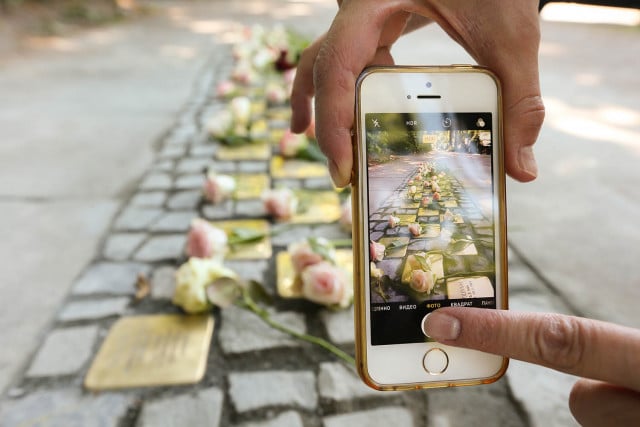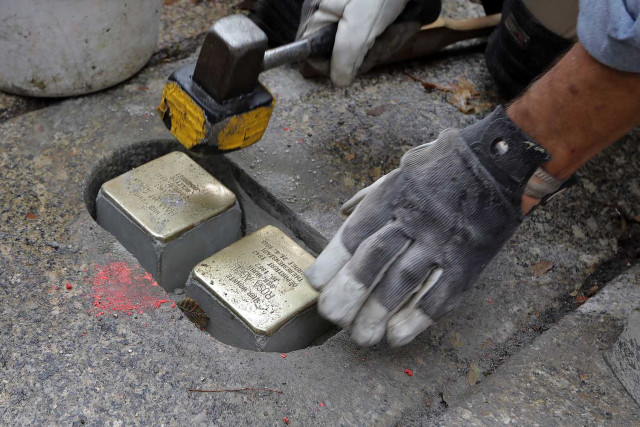Artist behind Germany’s Stolpersteine: ‘They're needed now more than ever’

On the 74th anniversary of the liberation of Auschwitz-Birkenau and with a resurgence in xenophobia and racist sentiment, Gunter Demnig says remembering the horrors of the Holocaust is now more important than ever.
For language learners: we've highlighted some useful vocabulary in this news story. You'll find the German translations at the bottom of the article.
The name Gunter Demnig may not be familiar to many, although anyone who has spent time walking the streets of European towns or cities are likely to be familiar with his work.
Stolpersteine - translated roughly as stumbling blocks or tripping stones - are small, square-shaped stones decorated in bronze. The are placed on streets, footpaths and walkways used by everyday pedestrians, designed to remind people of all victims of the Nazi regime and the Second World War.
Each stone is engraved with an inscription containing details of the victims lives, their treatment - and their eventual fate.
International Holocaust Remembrance Day takes place this Sunday, January 27th. It will mark 74 years since the Auschwitz-Birkenau Concentration Camp was liberated by the Red Army, with sombre vigils and memorials to be held across the globe.
SEE ALSO: Stolpersteine: Standing defiantly in communities amid rising tensions
SEE ALSO: Children of Nazis and their victims share family history to mark Holocaust Remembrance Day
Demnig believes that despite almost three quarters of a century passing since the end of the Second World War, the stones - and memorials like them - are needed now, perhaps more than ever.
“When some people from the AfD (Alternative for Germany) stand up and say that we do not need to be reminded of the Nazi era, I think we need (the stones) even more so,” Demnig told DPA.

In total, 70,000 stones have been placed in cities and towns in several European countries to commemorate the victims and remind people of the dangers of racism, xenophobia and anti-Semitism.
The stones are placed before the homes or the educational facilities of victims, illustrating a human connection with the past that could otherwise be lost.
Demnig, 71, who has laid most of the stones himself, said the motivation behind the project - which he began in the early 1990s - was to remind people that the victims of the Holocaust lived everyday lives and did many of the same things as contemporary residents.
“I realised that many people do not know about the fate of the people in the neighbourhood,” Demnig said.
Ancestors of victims of the Holocaust can contact Demnig with a request to lay a stone. Once their request has been verified, they will join a waiting list to have the stone laid.
The program is primarily funded through sponsorship, with each stone costing roughly €120. The project is officially the world’s largest decentralised memorial.

Although his work has been seen in almost 2,000 municipalities across Europe, he did not create the project with such lofty goals in mind.
“At the beginning, I thought it would be maybe 1,000 stones,” he said.
Over 20 years later, he continues to lay the stones - despite being officially retired.
Stolpersteine can be seen in cities, towns and villages across Germany, with one notable exception.
Munich has refused requests to lay Stolpersteine, arguing that the symbolism of victims once again being under the boots of Germans may be too much for some victims.
Demnig has dismissed this criticism however, saying that it trivializes the true nature of the Nazi extermination program.
“The Nazis had a very specific murder and mass extermination program,” he said.
“By walking over the stones, you can (shine the brass) to make them brighter, so that you can keep the memory alive and honour the victims.”
German vocabulary
die Stolpersteine: Literally, ‘stumble stones’, the term has a number of meanings. The word Stolperstein - without the ‘e’ - can indicate a potential issue or problem. An old anti-semitic German saying when tripping on a protruding rock or stone while walking was “a Jew must be buried here”. Additionally, during the Second World War the Nazis often used Jewish gravestones to cover holes in the pavement, thereby connecting historical incidences of antisemitism to a modern commemoration of the victims.
stolpern: to trip or stumble
der Holocaust-Gedenktag: Holocaust Remembrance Day
die Opfer des Nationalsozialismus: the victims of National Socialism
das dezentralisierte Denkmal: decentralised memorial
das Schicksal: the fate
der Antisemitismus: anti-semitism
p.p1 {margin: 0.0px 0.0px 0.0px 0.0px; font: 12.0px Helvetica}
p.p2 {margin: 0.0px 0.0px 0.0px 0.0px; font: 12.0px Helvetica; min-height: 14.0px}
die Massenvernichtung: mass extermination
We're aiming to help our readers improve their German by translating relevant vocabulary from our news stories of the day. Did you find articles like these useful? Do you have any suggestions? Let us know.
Comments
See Also
For language learners: we've highlighted some useful vocabulary in this news story. You'll find the German translations at the bottom of the article.
The name Gunter Demnig may not be familiar to many, although anyone who has spent time walking the streets of European towns or cities are likely to be familiar with his work.
Stolpersteine - translated roughly as stumbling blocks or tripping stones - are small, square-shaped stones decorated in bronze. The are placed on streets, footpaths and walkways used by everyday pedestrians, designed to remind people of all victims of the Nazi regime and the Second World War.
Each stone is engraved with an inscription containing details of the victims lives, their treatment - and their eventual fate.
International Holocaust Remembrance Day takes place this Sunday, January 27th. It will mark 74 years since the Auschwitz-Birkenau Concentration Camp was liberated by the Red Army, with sombre vigils and memorials to be held across the globe.
SEE ALSO: Stolpersteine: Standing defiantly in communities amid rising tensions
SEE ALSO: Children of Nazis and their victims share family history to mark Holocaust Remembrance Day
Demnig believes that despite almost three quarters of a century passing since the end of the Second World War, the stones - and memorials like them - are needed now, perhaps more than ever.
“When some people from the AfD (Alternative for Germany) stand up and say that we do not need to be reminded of the Nazi era, I think we need (the stones) even more so,” Demnig told DPA.

In total, 70,000 stones have been placed in cities and towns in several European countries to commemorate the victims and remind people of the dangers of racism, xenophobia and anti-Semitism.
The stones are placed before the homes or the educational facilities of victims, illustrating a human connection with the past that could otherwise be lost.
Demnig, 71, who has laid most of the stones himself, said the motivation behind the project - which he began in the early 1990s - was to remind people that the victims of the Holocaust lived everyday lives and did many of the same things as contemporary residents.
“I realised that many people do not know about the fate of the people in the neighbourhood,” Demnig said.
Ancestors of victims of the Holocaust can contact Demnig with a request to lay a stone. Once their request has been verified, they will join a waiting list to have the stone laid.
The program is primarily funded through sponsorship, with each stone costing roughly €120. The project is officially the world’s largest decentralised memorial.

Although his work has been seen in almost 2,000 municipalities across Europe, he did not create the project with such lofty goals in mind.
“At the beginning, I thought it would be maybe 1,000 stones,” he said.
Over 20 years later, he continues to lay the stones - despite being officially retired.
Stolpersteine can be seen in cities, towns and villages across Germany, with one notable exception.
Munich has refused requests to lay Stolpersteine, arguing that the symbolism of victims once again being under the boots of Germans may be too much for some victims.
Demnig has dismissed this criticism however, saying that it trivializes the true nature of the Nazi extermination program.
“The Nazis had a very specific murder and mass extermination program,” he said.
“By walking over the stones, you can (shine the brass) to make them brighter, so that you can keep the memory alive and honour the victims.”
German vocabulary
die Stolpersteine: Literally, ‘stumble stones’, the term has a number of meanings. The word Stolperstein - without the ‘e’ - can indicate a potential issue or problem. An old anti-semitic German saying when tripping on a protruding rock or stone while walking was “a Jew must be buried here”. Additionally, during the Second World War the Nazis often used Jewish gravestones to cover holes in the pavement, thereby connecting historical incidences of antisemitism to a modern commemoration of the victims.
stolpern: to trip or stumble
der Holocaust-Gedenktag: Holocaust Remembrance Day
die Opfer des Nationalsozialismus: the victims of National Socialism
das dezentralisierte Denkmal: decentralised memorial
das Schicksal: the fate
der Antisemitismus: anti-semitism
p.p1 {margin: 0.0px 0.0px 0.0px 0.0px; font: 12.0px Helvetica} p.p2 {margin: 0.0px 0.0px 0.0px 0.0px; font: 12.0px Helvetica; min-height: 14.0px}
die Massenvernichtung: mass extermination
We're aiming to help our readers improve their German by translating relevant vocabulary from our news stories of the day. Did you find articles like these useful? Do you have any suggestions? Let us know.
Join the conversation in our comments section below. Share your own views and experience and if you have a question or suggestion for our journalists then email us at [email protected].
Please keep comments civil, constructive and on topic – and make sure to read our terms of use before getting involved.
Please log in here to leave a comment.